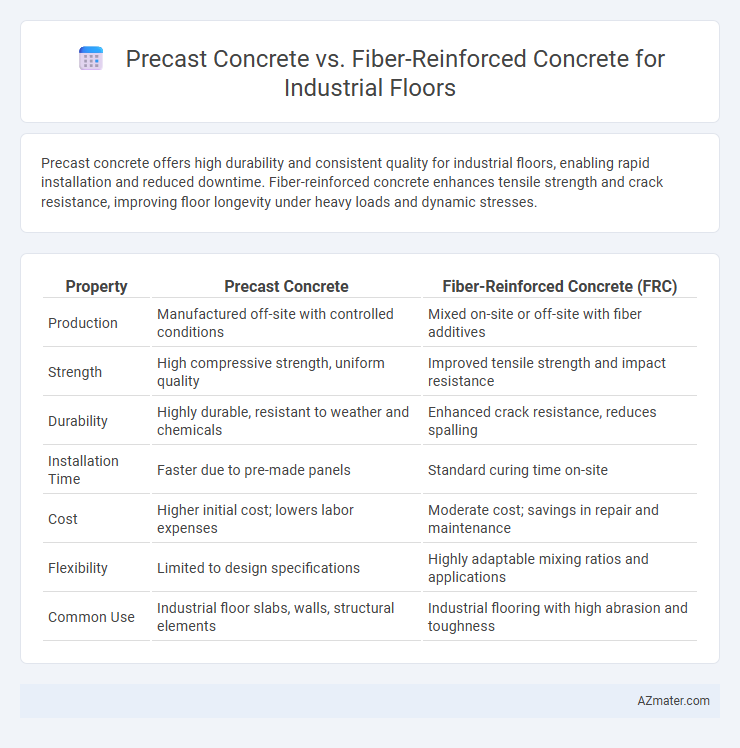Precast concrete offers high durability and consistent quality for industrial floors, enabling rapid installation and reduced downtime. Fiber-reinforced concrete enhances tensile strength and crack resistance, improving floor longevity under heavy loads and dynamic stresses.
Table of Comparison
| Property | Precast Concrete | Fiber-Reinforced Concrete (FRC) |
|---|---|---|
| Production | Manufactured off-site with controlled conditions | Mixed on-site or off-site with fiber additives |
| Strength | High compressive strength, uniform quality | Improved tensile strength and impact resistance |
| Durability | Highly durable, resistant to weather and chemicals | Enhanced crack resistance, reduces spalling |
| Installation Time | Faster due to pre-made panels | Standard curing time on-site |
| Cost | Higher initial cost; lowers labor expenses | Moderate cost; savings in repair and maintenance |
| Flexibility | Limited to design specifications | Highly adaptable mixing ratios and applications |
| Common Use | Industrial floor slabs, walls, structural elements | Industrial flooring with high abrasion and toughness |
Introduction: Comparing Precast and Fiber-Reinforced Concrete
Precast concrete offers high durability and fast installation for industrial floors, with factory-controlled conditions ensuring consistent quality and reduced onsite labor. Fiber-reinforced concrete enhances tensile strength and crack resistance through integrated fibers, improving impact resistance and reducing maintenance needs in heavy-duty applications. Both materials provide distinct advantages; selecting the optimal solution depends on project requirements for speed, durability, and load-bearing capacity.
Material Composition and Structural Differences
Precast concrete for industrial floors is composed of high-strength cement, aggregates, and controlled water content, cured off-site to ensure uniformity and durability, while fiber-reinforced concrete integrates synthetic, steel, or glass fibers directly into the mix to enhance tensile strength and crack resistance. Structurally, precast concrete slabs are designed for quick installation and consistent load-bearing capacity, whereas fiber-reinforced concrete offers improved impact resistance and toughness, reducing the need for additional reinforcement and minimizing surface wear in high-traffic industrial settings. Material composition in fiber-reinforced concrete allows for distributed stress absorption across the floor, contrasting with the homogenous, modular design of precast units engineered for precise structural support.
Installation Methods and Construction Speed
Precast concrete offers rapid installation for industrial floors through factory-made panels that are transported and assembled on-site, minimizing curing time and enabling faster project completion. Fiber-reinforced concrete requires traditional casting and curing processes on-site but eliminates the need for steel reinforcement placement, simplifying installation and reducing labor costs. Overall, precast concrete maximizes construction speed via off-site production, while fiber-reinforced concrete enhances installation efficiency through reinforcement integration and faster on-site handling.
Load-Bearing Capacity and Durability
Precast concrete offers high load-bearing capacity due to controlled factory conditions ensuring consistent strength, making it ideal for heavy industrial floor applications. Fiber-reinforced concrete enhances durability by reducing cracking and increasing resistance to wear and impact, extending the floor's lifespan under dynamic loads. Comparing both, precast concrete provides superior structural reliability, while fiber-reinforced concrete delivers improved toughness and maintenance performance in industrial flooring.
Crack Resistance and Flexural Strength
Precast concrete offers high crack resistance due to controlled factory curing, ensuring uniform strength and durability for industrial floors. Fiber-reinforced concrete enhances flexural strength by distributing loads more evenly and reducing crack propagation through synthetic or steel fibers embedded within the mix. Both materials improve industrial floor performance, but fiber-reinforced concrete provides superior toughness and resistance to dynamic stresses.
Cost Analysis: Initial Investment and Lifecycle
Precast concrete for industrial floors typically requires a higher initial investment due to manufacturing, transportation, and installation costs, but offers reduced labor expenses and faster construction times. Fiber-reinforced concrete lowers upfront costs with simplified mixing and placement processes while enhancing durability and reducing maintenance expenses over the lifecycle. Lifecycle cost analysis favors fiber-reinforced concrete when factoring in improved crack resistance and extended service life, which minimize repair frequency and associated downtime in industrial environments.
Maintenance Requirements and Longevity
Precast concrete offers high durability with minimal maintenance, benefiting from factory-controlled production that ensures consistent quality and reduced susceptibility to on-site damage. Fiber-reinforced concrete enhances crack resistance and impact durability on industrial floors, reducing repair frequency and extending service life under heavy loading conditions. Both materials provide longevity, but precast concrete's standardized curing process typically delivers superior dimensional stability, while fiber reinforcement optimizes toughness and reduces maintenance in environments subject to mechanical stress.
Sustainability and Environmental Impact
Precast concrete for industrial floors offers enhanced sustainability through reduced material waste and energy-efficient factory production processes, minimizing site disturbances and carbon footprint. Fiber-reinforced concrete improves durability and crack resistance, extending the floor's lifespan and reducing the need for repairs, which lowers long-term environmental impact. Both materials contribute to eco-friendly construction, but precast concrete's controlled manufacturing and recyclability provide a stronger advantage in sustainable industrial flooring solutions.
Industry Standards and Performance Compliance
Precast concrete for industrial floors adheres to ASTM C150 and ACI 318 standards, ensuring consistent strength, durability, and load-bearing capacity for heavy machinery. Fiber-reinforced concrete complies with ASTM C1116 and ACI 544, offering enhanced crack resistance and impact performance while meeting tensile and flexural strength requirements critical in industrial settings. Both materials must align with ISO 13822 for serviceability and safety, but fiber-reinforced concrete often provides superior durability under dynamic loads and reduces maintenance costs over time.
Choosing the Right Concrete Solution for Industrial Floors
Precast concrete offers high durability and quick installation for industrial floors, making it ideal for facilities requiring rapid turnaround and consistent quality. Fiber-reinforced concrete enhances toughness and resistance to cracking, beneficial in environments with heavy machinery and dynamic loads. Selecting the right concrete solution depends on factors such as load capacity, installation speed, and long-term maintenance needs specific to industrial applications.

Infographic: Precast concrete vs Fiber-reinforced concrete for Industrial floor
 azmater.com
azmater.com